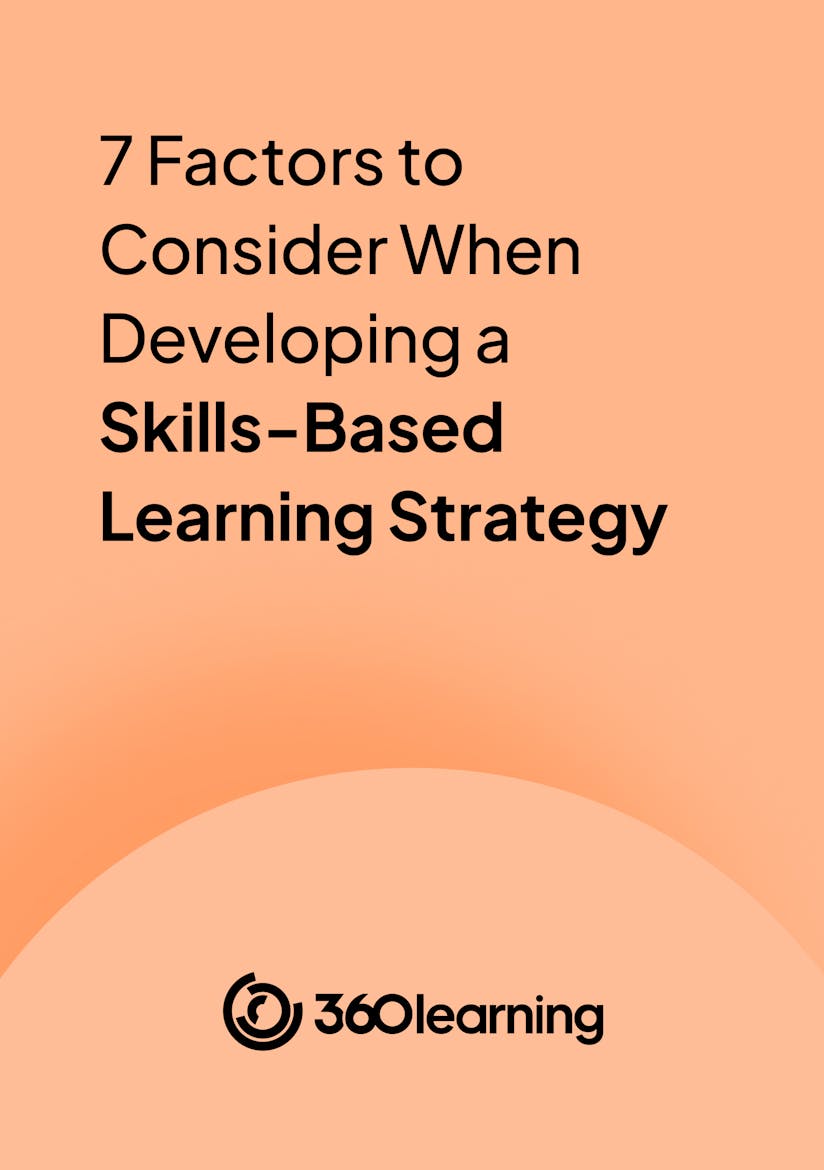
L&D teams are too often treated like an internal service desk—fielding one-off training requests, delivering soft skills courses, or rolling out programs with little connection to what the business is actually trying to achieve.
It’s not that these efforts aren’t valuable. But they’re not always aligned with the outcomes executives and stakeholders care about most: growth, efficiency, customer success, innovation.
The result is learning initiatives that are well-intentioned but neglected. Programs that sound good on paper but struggle to show impact where it counts.
To shift this perception, L&D leaders must stop acting like order-takers and become true strategic partners. That means rethinking how training is designed, measured, and communicated.
Of course, you already know this. But it’s far easier said than done.
In this article, we’ll show how aligning your learning strategy with your company’s business objectives is the key to proving the value of L&D. Then, we’ll walk through a step-by-step process for building programs that make a measurable impact and get noticed by leadership.

Guarantee a successful move to skills-based L&D
By providing your contact info, you agree to receive communications from 360Learning. You can opt-out at any time. For details, refer to our Privacy Policy.
What does aligning training strategy with business strategy mean?
Learning and development programs often focus on broad topics like leadership, negotiation, or time management. These initiatives sound relatively sensible—employees could always use better tactics to manage time or deal with disputes.
But in most cases, there’s no clear connection between these training sessions and what the business actually needs. Employees are stretching to meet KPIs, and training can feel like a distraction. It’s little wonder then that people lose interest, completion rates fall off, and there’s no real sense of progress.
Instead, the starting point for any training initiative must be a fundamental question: What is the business trying to achieve right now?
Maybe the organization wants to boost customer satisfaction, drive revenue growth, cut costs, or improve employee retention. Each of these strategic goals comes with its own set of challenges and opportunities for L&D to contribute in a meaningful way.
Aligning learning initiatives with these top-level objectives ensures that training is not just relevant, but drives business success. And it keeps employees motivated and engaged, because you’re helping them achieve their most pressing goals.
Why strategic alignment matters
Aligning Learning and Development with top-level business objectives ensures:
- Relevance. Employees are more likely to engage with material that helps them build the skills to reach their objectives. And leaders are more likely to encourage team members to complete the required tasks.
- Clarity and consistency. Departments often operate in silos, with limited visibility into what truly matters to the customer or to other teams. When L&D programs are tied to clearly articulated business goals, they help break down those barriers.
- Return on investment. Learning professionals are constantly having to prove the ROI of L&D to get more budget and resources. If you can draw a clear line between your courses and real business results, this becomes a very easy story to tell.
- Culture of learning. Most employees are driven by team and company success—at least in part. So again, if you can tie courses to higher-order objectives, you’re more likely to get consistent buy-in and enthusiasm for learning across the organization.
This is not a new priority for L&D teams. LinkedIn’s 2024 Workplace Report found it was the number one focus area for learning professionals—for the second year in a row.
And the level of strategic alignment is also a clear indicator of how advanced and developed your L&D program is.
Strategic alignment is a marker of L&D maturity
The ability to orient your L&D program around high-end business needs shows the quality of learning you’re able to deliver. The best L&D programs go beyond offering cookie cutter materials and responding to ad hoc requests—they develop the skills and knowledge needed for the business to succeed:
As the Maturity Model above shows, strategic alignment is a sure sign that your L&D approach is advanced and impactful. Rather than reacting to ad hoc requests, more mature Learning and Development strategy actually builds from and incorporates overall business initiatives and objectives.
The immediate benefit is that learning feels more relevant for teams. Courses give them the skills needed to directly achieve their key goals. And importantly, you can show a clear return on investment for leadership.
The pinnacle of this maturity model is what we call “transformative” learning and development. These programs not only align with the organization’s objectives for the coming quarters, but can look forward several years and build the skills you’ll need as the business evolves.
Great L&D teams can even be the catalyst for that evolution.
How to align L&D with core business objectives
Enough of the why. It’s time to explore the how. Here are seven critical steps to bring your L&D strategy into alignment with the business overall.
1. Identify business objectives you can influence
Start with conversations, not content. Meet with senior leaders, department heads, and key stakeholders to get a clear picture of the company’s strategic goals and current pain points.
- What are the top business objectives for the next 6–12 months?
- What key metrics (e.g., revenue, retention, NPS, cost savings) are you trying to move?
- Where are the biggest performance or capability gaps?
Your goal is to understand what success looks like for the business and where L&D can play a role in accelerating that success.
2. Identify performance and skills gaps
Once the business goals are clear, work with department leaders to pinpoint skills gaps, as well as knowledge or behaviors that are missing.
For example:
- If customer churn is high, is the issue tied to poor onboarding or ineffective customer service?
- If deal sizes are too low, is your pricing structure to blame? Or do sales teams need help negotiating?
- If the company is scaling quickly, are new managers equipped to lead?
This step is about diagnosing root causes—not just taking training requests at face value.
3. Set learning objectives
Now, convert those performance and capability needs into clear, measurable learning objectives. For example:
- Suppose one business goal is to increase upsell revenue by 15%. Your learning objective could be to train account managers on consultative selling techniques and product value positioning.
- Another business goal is to improve customer support satisfaction scores. The learning objective could be to teach support teams advanced de-escalation and communication skills.
This is the critical “alignment” moment—tying business outcomes directly to learning outcomes. Now, learning isn't just about personal growth—it’s about delivering measurable business impact.
4. Set meaningful success metrics
Less mature L&D strategies focus on attendance or course satisfaction surveys. These can be helpful indicators, but they don’t measure impact or prove any real Learning and Development ROI.
Ideally, your success measures will derive directly from core business objectives. A few examples:
- The company goal is to sign 200 new customers this quarter. How many new customers signed following a specific sales training initiative? Can you point to increased win rates or faster growth in new deals?
- A company goal is to reduce the rate of employee churn. Can you show that a new onboarding plan or performance and promotion process brought the rate down.
Tying success to these higher-order measures not only helps you focus and build more impactful programs, it’s the best way to prove the value of L&D to the business.
It’s critical to do this before you implement training programs. Too often, measurement is an afterthought, which makes it awkward and difficult to do well.
5. Author and tailor content
With learning objectives in hand, build learning programs that are focused, relevant, and directly tied to solving real business problems. Prioritize:
- Context: Use real company scenarios, customer data, or case studies.
- Modularity: Break programs into short, actionable learning experiences.
- Personalization: Adapt content to the learner’s role, level, or performance data.
- Blended learning: Combine digital, on-the-job, and live elements to reinforce behavior change.
Your best bet to achieve all of the above is to use subject-matter experts as much as possible. These are the trusted, experienced team members others look to for inspiration and advice. Provide an easy, efficient way for them to craft and deliver courses, and you almost guarantee that learning will be better tailored to both business and individual needs.
6. Roll out learning
Most of your attention will likely go to planning and strategic analysis. But launching new training paths is a great reason to build excitement and get team members engaged.
Important considerations here include:
- Making the connection between training and reaching goals. Many employees will be pessimistic or fatigued with corporate training programs. Win them back by showing just how valuable your program is to meet their top objectives.
- Getting executive sponsorship and buy-in. They often set business goals, so you need them to evangelize the value of learning in reaching them.
- Involving managers early and often. Managers are critical to ensuring training translates into improved performance. Encourage them to model behaviors and track progress, and equip them with follow-up tools, discussion guides, and coaching tips.
- Finding the right communication balance. You certainly need to share progress and keep people motivated. But overdo it and you’ll quickly turn people off.
With most of the hard work behind you, you can enjoy each launch and truly believe in the outcomes ahead. And because you’re aligning with core company goals, it should be easier to build enthusiasm and keep people engaged.
7. Communicate the impact
Tracking the impact of L&D is only half the battle—the other half is making sure the rest of the business knows about it. L&D leaders must proactively shape and share a compelling narrative about how training efforts are moving the needle on business outcomes.
This means:
- Telling a story with data: Don’t just report completion rates. Highlight how training helped reduce churn, close deals faster, or improve employee engagement—and tie it back to business KPIs.
- Creating visibility: Share success stories in company all-hands, internal newsletters, or dashboards that make L&D’s impact clear and accessible.
- Speaking the language of the business: Frame learning wins in terms executives care about—like ROI, productivity gains, or customer satisfaction.
- Celebrating progress: Recognize learners, managers, and especially subject-matter experts who have contributed to these successes to boost morale and drive engagement.
The goal is to elevate L&D from a support function to a strategic driver of business performance. When you own the narrative, you ensure L&D gets the visibility, buy-in, and investment it deserves.
Build towards strategic, transformative learning and development
Aligning L&D with business strategy isn’t just a smart move—it’s the only way to ensure your training efforts are seen as valuable by leadership, impactful to operations, and essential to the company’s long-term goals.
When learning is tied to business outcomes, employees no longer see it as a box to check. They see it as a tool to reach personal and team milestones, and to move the needle on KPIs that matter.
This inevitably leads to the exact outcomes you’ve been looking for all along: better adoption, higher engagement rates, and a clear connection between your learning strategy and overall business success.
Want to benchmark your current L&D strategy? Try our free Maturity Model.





